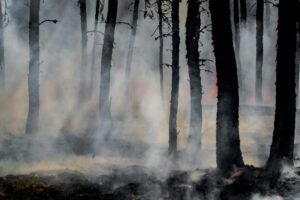
Wildfire risk is evolving, becoming more unpredictable and challenging for insurers to navigate. To shed light on this complex issue, we sat down with Paul Brady, Head of Wildfire Insights & Mitigation for Property Guardian, a Green Shield company. With more than 15 years of hands-on experience as a firefighter for the United States Forest Service, Paul brings unparalleled expertise to the world of wildfire risk management. Now in the insurance sector, he leverages his deep understanding of wildfire behavior to help underwriters and property owners move beyond mere risk scores and gain a transparent, actionable view of their wildfire exposure. In this Q&A, Paul shares how Property Guardian is leading the charge in wildfire risk mitigation, employing cutting-edge technology and on-the-ground experience to empower both the industry and its clients.
Q: What is your goal as a Certified Wildfire Mitigation Specialist for Property Guardian?
A: I want to bring transparency to the industry and deepen understanding of wildfire risk beyond a simple risk score. This means considering fire characteristics like flame length, rate of spread, and effective mitigation strategies — similar to how the fire service approaches it. In contrast, the insurance sector often applies National Fire Protection Agency (NFPA) standards uniformly to all structures. While these standards are beneficial, they don’t fully address property-specific risk. Evaluating a property’s risk and determining appropriate standards are two distinct tasks, and the connection between them is often unclear in the insurance industry. This lack of clarity creates a “black box” for underwriters and loss control consultants when assessing property risk.
We need to ask, “What would happen if a fire occurred here?” and make that information transparent to both the insured and the underwriter. When Property Guardian approached me with a commitment to transparency, I saw it as a unique opportunity to introduce a new level of insight and openness to the market, and I was excited to be part of it.
Q: Why is wildfire risk becoming so difficult for the industry to insure?
A: Many insurance carriers are withdrawing from wildfire-prone states due to a lack of effective strategies for managing wildfire risk, a challenge intensified by climate change and the increasing frequency of wildfires. Relying solely on risk scores to insure properties can lead to substantial losses when major fires impact areas with seemingly low-risk scores, undermining confidence in risk assessment tools and strategies. This disconnect prompts carriers to question their ability to accurately underwrite wildfire risk in these states.
When confidence in these tools diminishes, carriers often see no viable option but to exit these markets, especially if they cannot set premiums that align with the perceived risk or if clients are unwilling to pay those premiums. Addressing wildfire risk will continue to be increasingly complex, and the insurance industry is not fully equipped to tackle these evolving challenges.
Q: Do you think wildfire will ultimately become an uninsurable risk?
A: No, I don’t believe wildfire risk will become uninsurable. What’s needed is far greater transparency for both carriers and the insured. Carriers must understand the specific wildfire risk for each property, including the key factors that influence what would happen if a wildfire occurred. Instead of relying on a single score, we need a deeper understanding of how a fire might spread and what mitigation measures could best protect the property.
With insights comparable to those of a firefighter, carriers can manage wildfire risk more effectively rather than operating in uncertainty. Technology must advance to support insuring properties in high-risk wildfire areas, but wildfire risk will remain insurable. The question is, who will be first to reach a level of understanding that allows them to navigate wildfire risk as effectively as a firefighter?
Q: How is Property Guardian navigating the exposures of wildfire risk?
A: Property Guardian combines top-tier technology with deep expertise, setting us apart from companies that rely solely on one or the other. We leverage the most advanced technology available to comprehensively assess wildfire risk, using multiple, up-to-date models and high-resolution aerial imagery to capture current vegetation conditions—an area where outdated sources like Google Earth fall short, especially with vegetation’s constant changes.
Our approach is not just about data but also about applying our expertise to interpret that data, assess the wildfire risk for each property, and identify targeted mitigation efforts. Whether improving a high-risk property or further safeguarding a low-risk one, we aim to provide actionable insights that enhance resilience.
Q: How could the insurance industry better mitigate and educate insureds about fire risk?
A: A collaborative approach between the insured and the carrier can create a strong, effective partnership. In the commercial sector, these partnerships on large accounts are nearly seamless. However, with residential property owners, it’s more sensitive — it’s about their home, their safe place.
From the insured’s perspective, understanding this as a partnership helps them see that insurance isn’t just protection but a shared commitment with the carrier. From the carrier’s side, actively seeking partnerships with homeowners who are dedicated to mitigating their risks can be mutually beneficial.
The industry could improve in educating on mitigation, which allows professionals like myself—or those within the carrier—to have open, supportive conversations with homeowners. This approach helps us work together to protect their property without feeling intrusive but rather as trusted allies in safeguarding their home.

